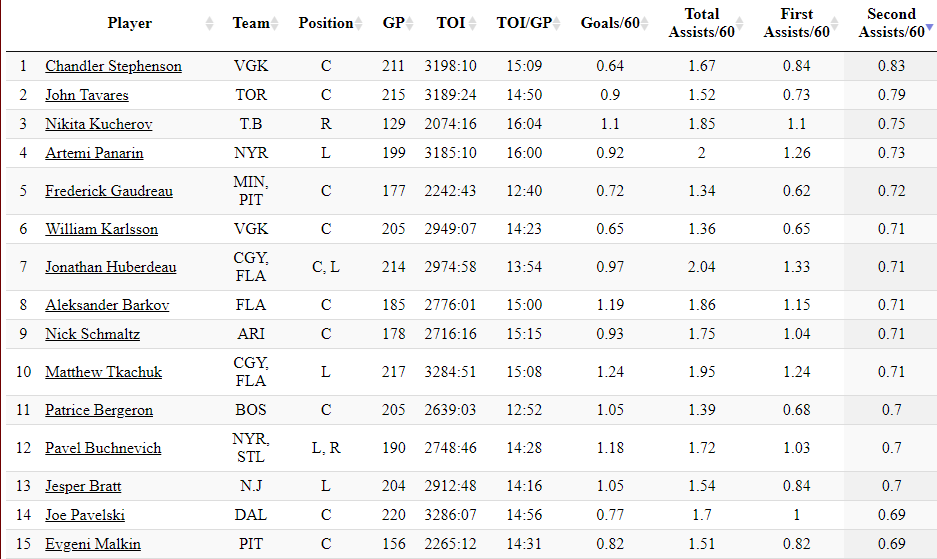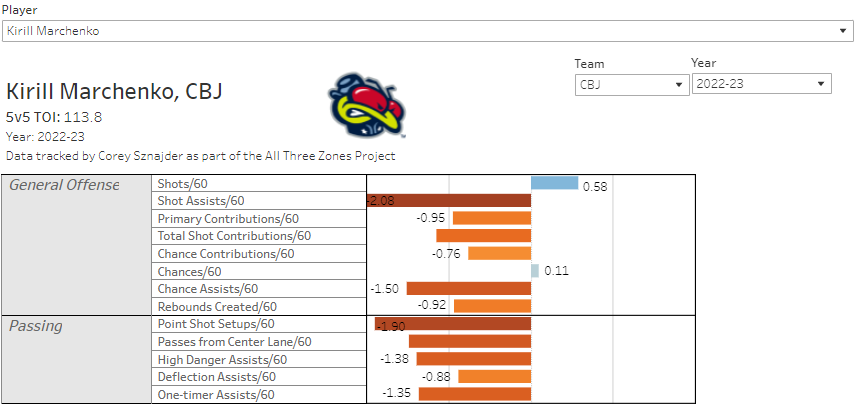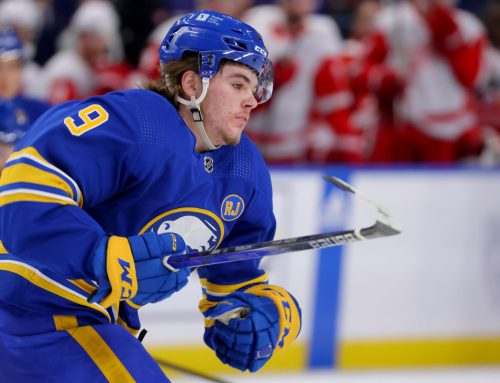The 2023-24 Dobber Hockey Fantasy Guide is now available in the Dobber Shop! It has everything fantasy hockey players need like projections, depth charts, prospect discussions, a draft list, individual articles, and a whole lot more. It is also updated with the offseason news so there’s no worry about outdated information for your drafts. Help support us and give your fantasy research an offseason boost at the same time.
*
Toronto signed veteran backup goalie Martin Jones to a one-year contract. Alex MacLean had his breakdown here.
It is an interesting move because Joseph Woll is not exempt from waivers, as Alex pointed out, which means either carrying three goalies or potentially losing one on waivers. Jones may not get claimed, but it creates an interesting backup dilemma, and potential start dilemma of Samsonov goes through any lengthy injury. If Jones really does steal starts from Woll all season, something has probably gone very wrong for the team.
*
One thing I am conscious of when I write about fantasy hockey is to not mislead with stats. All fantasy sports are a numbers game; a math problem to solve. It just so happens that the results of the numbers game are determined by real people playing a professional game that is loaded with variance, particularly on a day-to-day basis.
One of the stats that can be misleading is secondary assists (A2). There have been studies going back years showing that these helpers – from forwards at even strength – regress heavily when players finish at the top or the bottom of the leaderboard. For example, John Tavares led all forwards in A2/60 back in 2021-22 with 1.06, a mark nearly 80% higher than his previous career-best for a full 82-game season (2010-11, 0.59/60). That rate of 1.06/60 in 2021-22 predictably cratered down to 0.58/60 in 2022-23, cutting his A2 totals nearly in half. Adding 13 power-play points helped balance out that regression, which is why an A2 regression is not the end of the world.
However, saying that there will be regression from a player with an A2 outlier doesn't tell us the whole story. While there are a couple of surprises for the top A2/60 performers over the last three seasons, like Frederick Gaudreau being in the top-10, the leaderboard looks mostly like a lot of the top players/playmakers in the league (from Natural Stat Trick):

When we look at the very bottom of the A2/60 leaderboard over the last three seasons, outside of a couple of options, they are almost all bottom-6 players, and bottom-6 grinders to boot:

The players at the top and the bottom of the A2 leaderboard show us what makes sense intuitively: top playmakers – or good offensive threats playing with top players – will garner more secondary assists, and the opposite is also true. More goals mean more secondary assists. Who knew?
Let's look at the leaders and laggers by secondary assists at even strength for the 2022-23 season. To start, let's look at some players that were at the top, finishing at least one standard deviation above average, and thus candidates for negative regression.
Pavel Zacha (BOS – 1.01 A2/60)
Last season, Zacha tied for the league lead in secondary assist rate, putting up 18 such helpers in 82 games. Over his prior three seasons, spanning 185 games in New Jersey, he had just 16 second assists. The crux here is the team scored 4.09 goals/60 with him on the ice, having never reached even 2.9 in any full season prior. The huge leap in A2 will regress, but there were other reasons why he had 18 of those assists besides just luck.
With Patrice Bergeron retiring and David Krejci's return looking unlikely, it's possible Zacha will just step into a top-line centre role, likely beside Brad Marchand. It really isn't a bad place to be, but over the last three seasons, Boston's even strength goal rate with Marchand on the ice without Patrice Bergeron fell about 9%, and it gets much worse without both Bergeron and David Pastrnak. In other words, Zacha's improved role might not mean as big of a production bump as we think, especially if the power play struggles.
Andrei Kuzmenko (VAN – 1.01 A2/60)
There has been a lot made of Kuzmenko's shooting percentage – the highest in many years – but his secondary assist rate was tied for the league lead. Back in the 2021-22 season, of the three players to finish over 1.0 A2/60, the smallest drop in 2022-23 was over 24%, then 36%, then 45%. If Kuzmenko's A2/60 were to fall by just 33%, we can knock off six points from his 2022-23 total of 74. That is just a modest drop, too, so things could get a lot worse.
What is notable is that Elias Pettersson also finished top-10 in A2/60. He and Kuzmenko fed well off each other at all offensive strength, and Pettersson's even-strength shooting percentage was well within norms. There is regression coming for Kuzmenko, and I don't think he gets to 74 points again, but he should still be considered a 60-point threat.
Jamie Benn (DAL – 0.92 A2/60)
It was a resurgent campaign for Benn, who posted a five-year high in goals (33) and seven-year high in assists (45). The power play helped Benn immensely, but he had as many A2 (15) in 82 games as he had in his prior 134 games. The difference-maker here was the team's shooting percentage with Benn on the ice, which was 14.2%. His previous career-high was 11.5% in 2017-18 and averaged 8.5% over the previous three seasons. His 14.2% on-ice shooting led all regular NHL forwards, and by a comfortable margin.
Like Kuzmenko, just a natural regression in A2/60 would knock 5-6 points off from Benn's point total. It would still leave a very good fantasy option, but I'm not sure he's a true 80-point threat. Regression in multiple areas could easily mean a cap of 70 points this upcoming campaign.
Yanni Gourde (SEA – 0.82 A2/60)
Excluding the Bubble and lockout seasons, Seattle finished with the highest team even-strength shooting percentage for a single campaign since 2007. Gourde's 11.1% on-ice shooting was high, but not even the highest of his career (11.9% in 2017-18). His A2/60 rate, though, was the highest of his career (by nearly 14%) and 183% higher than his three-year average from 2019-22 (seriously). Gourde managed more secondary assists (16) in 81 games than he did in his prior 200 games (13).
I have no problem believing Seattle is a good offensive team with depth scoring, but a full one-third of Goude's entire point total was secondary assists at even strength. It is just nowhere near sustainable. A drop of 30% of his A2 rate would knock about five points off that 48-point total. He can balance that out with improved power-play production, or overall shooting percentage, but there should be a lot of concern about Gourde being a 50-point threat.
Rickard Rakell (PIT – 0.77 A2/60)
It was a good season for Rakell last year as his 60 points and 0.73 points/game were both five-year highs. Importantly, the Pittsburgh power play's goal rate went up 25% when Rakell was skating with the big boys. If Rakell can stay on the top PP unit over Bryan Rust, it could help mitigate the incoming A2 regression the former is facing.
That he had a career season by A2/60 is a concern – he had 16 such helpers in 82 games, managing just 13 over his prior 122 regular season contests. Being in Pittsburgh, and not on a bad Anaheim team, has helped him to higher A2 rates the last two seasons than normal, but there is pullback coming of at least 3-4 points, if not more. However, as mentioned earlier, a full season on the top PP unit could help soften this drop quite a bit. He may still crest 60 points, even with that A2 regression (the Dobber Guide projected him for 58 in 77 games, so pretty bang-on his 2022-23 performance).
There are forwards at the other end of the A2 spectrum that need discussion as well. These players may – or may not – be in line for some extra point production in 2023-24 thanks to secondary helpers.
Kirill Marchenko (CBJ – 0.0 A2/60)
There were 288 forwards to crest the 750-minute mark at even strength and only two failed to register a single even-strength secondary assist. One was Vegas's Keegan Kolesar, and the other was Marchenko. He managed just four total assists in 59 games.
Marchenko's three full-ish seasons in the KHL produced 34 goals and 30 assists, so he has a track record of prioritizing scoring over playmaking. That disparity was stark in the NHL, though, with 21 goals and 4 assists. It wasn't just luck, either, as AllThreeZone's tracking data had Marchenko – in a small sample – with very poor playmaking numbers across the board:

We can expect Marchenko to register some second assists in 2023-24, but we also need to see improvement in his playmaking before he becomes a more rounded threat, and thus fantasy asset.
Michael Amadio (0.15 A2/60)
Amadio hasn't really had much fantasy relevance outside being a streaming option, but the trade of Reilly Smith may open a path for him to middle-6 minutes. A lack of power-play time will hurt, but his value needs to start somewhere.
In his first three seasons with Los Angeles, Amadio averaged 0.4 A2/60, not far Anze Kopitar's 0.44 A2/60. The winger's first season in Nevada produced a rate of 0.28 A2/60. In other words, his mark in 2022-23 appears to be an outlier. Positive regression could easily add 2-3 points to his total from last year, and that precludes better line mates, more minutes, and a consistent role. If he can play 75-80 games, he's a 40-point, 80-hit threat available for cheap in multi-cat formats.
David Perron (DET – 0.16 A2/60)
Detroit's veteran winger posted his lowest A2/60 mark since 2009-10, and it was less than one-third his three-year average from 2019-22 of 0.5/60. A normal rate in secondary assists would have had Perron over the 60-point mark last season.
The curious thing is that Detroit scored 3.5 goals/60 with Perron on the ice at even strength, his highest on-ice goal rate since 2017-18. He also had good playmaking data from the tracking we mentioned earlier. This seems a genuine case of some bad luck and if all else remains equal, Perron could be back over 60 points once again.
Viktor Arvidsson (LAK – 0.16 A2/60)
It is funny – weird? – to see a guy who set a career-high in assists (33) on this list, but Arvidsson's A2/60 rate at even strength was the lowest of his career. The 2021-22 season saw Arvidsson at 0.57/60 and his three-year average from 2019-22 was 0.38. In other words, doubling what he did in 2022-23 would still leave him short of recent career norms. Thankfully, he was a big power-play producer and that's where a lot of his assists came from.
Arvidsson presents an interesting proposition. He could easily add 3-4 secondary assists in 2023-24, but his PP assist rate was 178% higher in 2022-23 than his prior career-best mark. If that PP assist rate comes down – perhaps by a lot – it would far outweigh any positive A2 regression. His fantasy value will rest on that PP production and his shooting percentage, not secondary assist improvements.





 EDM
EDM TOR
TOR PIT
PIT VAN
VAN FLA
FLA MIN
MIN DET
DET COL
COL
